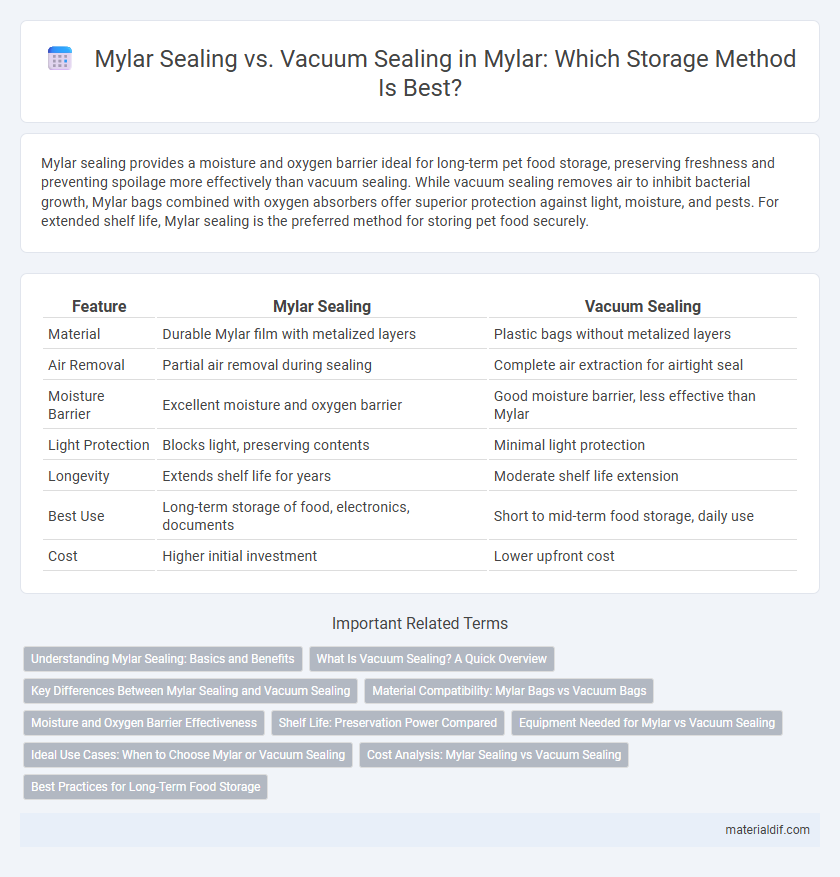Mylar sealing provides a moisture and oxygen barrier ideal for long-term pet food storage, preserving freshness and preventing spoilage more effectively than vacuum sealing. While vacuum sealing removes air to inhibit bacterial growth, Mylar bags combined with oxygen absorbers offer superior protection against light, moisture, and pests. For extended shelf life, Mylar sealing is the preferred method for storing pet food securely.
Table of Comparison
| Feature | Mylar Sealing | Vacuum Sealing |
|---|---|---|
| Material | Durable Mylar film with metalized layers | Plastic bags without metalized layers |
| Air Removal | Partial air removal during sealing | Complete air extraction for airtight seal |
| Moisture Barrier | Excellent moisture and oxygen barrier | Good moisture barrier, less effective than Mylar |
| Light Protection | Blocks light, preserving contents | Minimal light protection |
| Longevity | Extends shelf life for years | Moderate shelf life extension |
| Best Use | Long-term storage of food, electronics, documents | Short to mid-term food storage, daily use |
| Cost | Higher initial investment | Lower upfront cost |
Understanding Mylar Sealing: Basics and Benefits
Mylar sealing involves using a durable polyester film that provides a strong barrier against moisture, oxygen, and light, effectively preserving the freshness and extending the shelf life of stored items. Unlike vacuum sealing, which removes air to reduce oxidation, Mylar sealing focuses on creating an airtight, moisture-resistant environment by heat-sealing the pouch's edges. This method is particularly beneficial for long-term storage of food, pharmaceuticals, and sensitive materials, offering superior protection against environmental factors.
What Is Vacuum Sealing? A Quick Overview
Vacuum sealing removes air from the package before sealing to extend the shelf life of food by preventing oxidation and bacterial growth. Unlike Mylar sealing, which uses a heat-sealed metallized polyester film for barrier protection against moisture, light, and oxygen, vacuum sealing primarily relies on creating an airtight environment. This packaging method is ideal for preserving freshness in perishable foods, reducing freezer burn, and maintaining nutritional value.
Key Differences Between Mylar Sealing and Vacuum Sealing
Mylar sealing uses durable, multi-layer polyester film to create airtight packages that protect against moisture, oxygen, and light, whereas vacuum sealing removes air by suction before sealing with plastic bags. Mylar bags provide superior barrier properties and longer shelf life compared to traditional vacuum-sealed bags, making them ideal for long-term food storage and preservation. Unlike vacuum sealing, Mylar sealing often involves oxygen absorbers to further extend freshness and inhibit spoilage.
Material Compatibility: Mylar Bags vs Vacuum Bags
Mylar bags are made from biaxially-oriented polyethylene terephthalate (BoPET), offering excellent compatibility with dry, moisture-sensitive items due to their strong barrier properties and chemical resistance. Vacuum bags typically use materials like nylon and polyethylene, which provide good flexibility and puncture resistance but may not offer the same level of oxygen and moisture barrier as Mylar. Choosing between Mylar and vacuum bags depends on the specific material compatibility requirements, such as the need for long-term preservation or protection against volatile compounds.
Moisture and Oxygen Barrier Effectiveness
Mylar sealing provides superior moisture and oxygen barrier effectiveness compared to vacuum sealing by using multiple layers of polyester film coated with metalized materials that block air and moisture infiltration. This enhanced barrier significantly extends the shelf life of products by preventing oxidation and moisture-related spoilage. Vacuum sealing removes air but does not offer the same level of protection against gas permeability and moisture transmission as Mylar's metallized barrier.
Shelf Life: Preservation Power Compared
Mylar sealing extends shelf life by creating a moisture and oxygen-resistant barrier, significantly reducing oxidation and spoilage compared to vacuum sealing. Vacuum sealing removes air but may not protect against light and atmospheric gases, which can degrade food quality over time. For long-term preservation, Mylar bags combined with oxygen absorbers typically offer superior shelf life, often extending storage up to 20-30 years for dry goods.
Equipment Needed for Mylar vs Vacuum Sealing
Mylar sealing requires specialized Mylar bags and an impulse sealer or heat sealer to create an airtight, moisture-resistant barrier, ideal for long-term storage. Vacuum sealing demands a vacuum sealer machine that removes air from standard vacuum bags or rolls before heat sealing, ensuring reduced oxidation and preservation of freshness. While both methods use heat sealing equipment, Mylar sealing utilizes thicker, multi-layered bags offering superior puncture resistance compared to typical vacuum sealer bags.
Ideal Use Cases: When to Choose Mylar or Vacuum Sealing
Mylar sealing is ideal for long-term storage of dry goods like grains, seeds, and emergency supplies due to its excellent barrier properties against moisture, oxygen, and light. Vacuum sealing best suits perishable foods such as meats and vegetables, extending freshness by removing air and inhibiting bacterial growth. Choosing Mylar bags combined with oxygen absorbers is optimal for extended shelf life, while vacuum sealing offers convenience for daily refrigeration and short-term preservation.
Cost Analysis: Mylar Sealing vs Vacuum Sealing
Mylar sealing typically incurs lower upfront costs due to affordable materials and simpler equipment compared to vacuum sealing systems, which require specialized machines and more maintenance. Over time, vacuum sealing may offer cost savings through improved food preservation and reduced waste, but the initial investment remains significantly higher. Evaluating long-term expenses versus initial outlay reveals that Mylar sealing is more cost-effective for bulk or long-term storage without frequent resealing.
Best Practices for Long-Term Food Storage
Mylar sealing provides superior barrier properties against moisture, oxygen, and light, making it ideal for long-term food storage compared to vacuum sealing, which primarily removes air but may allow slow gas exchange. Best practices for mylar sealing include using oxygen absorbers to extend shelf life and heat-sealing bags to ensure airtight protection. Combining these methods enhances preservation by maintaining freshness and preventing spoilage in stored foods.
Mylar Sealing vs Vacuum Sealing Infographic

 materialdif.com
materialdif.com